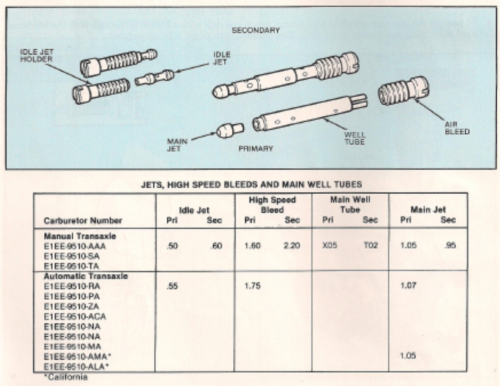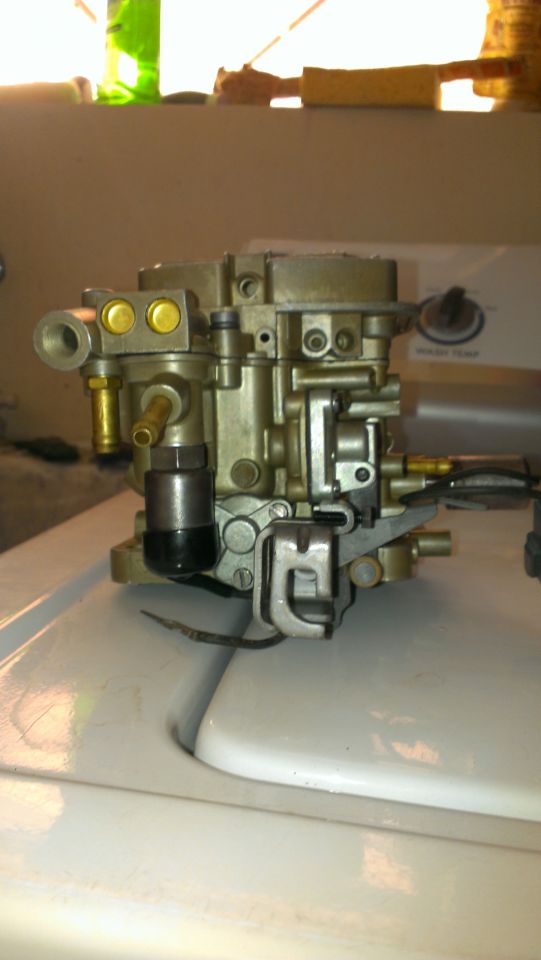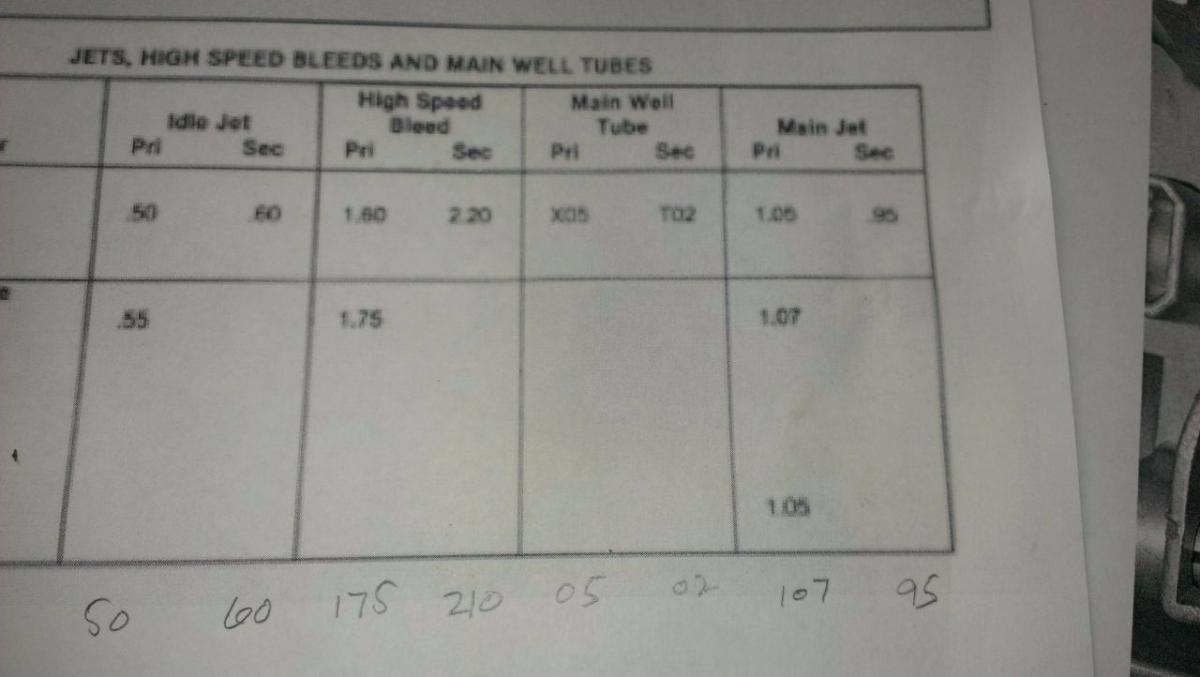its gets its vacume from the base mount of the carb all in house carbody pluming ...it has diaphragm spring and and ball thing to it inside .... vacume pulls and more gas is delivered to carb at same throttle level ... I also think tops are different im going to post pics
You are using an out of date browser. It may not display this or other websites correctly.
You should upgrade or use an alternative browser.
You should upgrade or use an alternative browser.
Single Carb Conversion 2 Barrel Progressive Holley,Weber 740 carb
- Thread starter westgl
- Start date

Help Support Classic Goldwings:
This site may earn a commission from merchant affiliate
links, including eBay, Amazon, and others.
- Joined
- Dec 3, 2009
- Messages
- 22,443
- Reaction score
- 262
- Location
- Van Nuys Ca.
- My Bike Models
- 1983 Interstate
2018 KLR 650
2018 BMW S1000 RR
- My Bike Logs forum link
- https://classicgoldwings.com/forums/dan-filipi.122/
[url=https://www.classicgoldwings.com/forum/viewtopic.php?p=96340#p96340:39hktusk said:westgl » Mon Sep 16, 2013 11:16 am[/url]":39hktusk]
Dan
This will help,
Look at i think page 3 it shows that what we thought was a power valve.
it is something different
This manual is a Very Good Reference for this carb
it give a some tuning info
Shows a High altude part that can be added to auto compensate for high altitudes.
This is a 27 meg file, but down loads fast
Link
https://docs.google.com/file/d/0B85S9Tw ... edit?pli=1
I forgot Joe and I had come across that file a couple months ago
Real good info in it.
West, check my signature. I have a link there how to use the gallery.
This single carb info is great stuff and needs to be kept out in the open, putting it in the gallery ensures the info won't get lost buried somewhere in the discussions.
this carb top ..shows the vents to bowl ...strait inline with air cleaner mount and the other just lower on right deeper in top its visable if you look ....im not so sure this is good either if westgl DFT is not like this
this is a pic of vented top ..one on right ..inline with cleaner mount ..on right just below deep in top ....not sure this is good if the DTF is not this way
- Joined
- Dec 3, 2009
- Messages
- 22,443
- Reaction score
- 262
- Location
- Van Nuys Ca.
- My Bike Models
- 1983 Interstate
2018 KLR 650
2018 BMW S1000 RR
- My Bike Logs forum link
- https://classicgoldwings.com/forums/dan-filipi.122/
West, does your's look like Joe's in that last pic?
Go to https://www.webercarbsdirect.com/v/vspfi ... 36DFEV.pdf and look. The jets 5 and 5a are air bleed jets and only control the way the venturi flow. The main and secondary fuel jets are 80 and 80a. Part 97 is a booster venturi and can be removed and modified or replaced larger (less air flow) or smaller (bigger airflow).
I played with the Holley/Weber 5200's for years on a built Dodge Shelby Charger 2.2 non-turbo. I over bored the 26 mm primary to 30 mm and the 27 mm secondary to 32 mm. They flowed just at 310 CFM when finished, over 273 CFM stock. That said it was still way too small for a 220 HP 2.2 so I went to a Holley 350 CFM 2 bbl and then to a Nascar GN V6 spec 390 CFM 4 bbl.
To make one of these Weber's respond you need to play with the 80 and 80a jet sizes. Messing too much with 5 and 5a air bleed jets cam mess up a good carb fast. You can apply a small coating of epoxy to the outsides of the 97 booster ventury after roughing up the surface to make the epoxy stick.
I played with the Holley/Weber 5200's for years on a built Dodge Shelby Charger 2.2 non-turbo. I over bored the 26 mm primary to 30 mm and the 27 mm secondary to 32 mm. They flowed just at 310 CFM when finished, over 273 CFM stock. That said it was still way too small for a 220 HP 2.2 so I went to a Holley 350 CFM 2 bbl and then to a Nascar GN V6 spec 390 CFM 4 bbl.
To make one of these Weber's respond you need to play with the 80 and 80a jet sizes. Messing too much with 5 and 5a air bleed jets cam mess up a good carb fast. You can apply a small coating of epoxy to the outsides of the 97 booster ventury after roughing up the surface to make the epoxy stick.

$44.95
Harley-Davidson Bar & Shield Logo Zipper Rugged Graphic Duffel Bag - Black
Wisconsin Harley-Davidson

$89.95
Harley-Davidson Trailblazer Hop Along Travel Duffel Bag - Black/Rust Vintage X-Large
Wisconsin Harley-Davidson

$36.42
$45.95
Triumph Bonneville T100, T120, Bobber, Thruxton, Street Twin, Cup & Scrambler (2016 - 2017) Haynes Repair Manual (Haynes Powersport)
Goodwill of Silicon Valley

$18.99
2001 2002 2003 2004 2005 Honda GoldWing GL1800/A Service Shop Repair Manual OEM
DD_Liquidators

$39.95
$49.95
Honda GL1500 Gold Wing Motorcycle (1993-2000) Service Repair Manual
Haynes Repair Manuals

$100.00
$169.99
1988 Honda Gold Wing GOLDWING GL1500 Service Shop Repair Manual OEM FACTORY 88
GLAVIS ENTERPRISES

$39.95
$59.95
Honda GL1800 Gold Wing 1800 (01-10) Haynes Repair Manual (Paperback)
Haynes Repair Manuals

$150.00
1984 Honda Gold Wing GL1200 Factory Service Manual Dealer GoldWing Shop Repair Workshop
GLAVIS ENTERPRISES

$38.97
$54.95
Clymer Honda GL1200, 1984-1987: Maintenance, Troubleshooting, Repair (Clymer Motorcycle)
Empty Estates

$69.00
$95.00
1986 Honda Goldwing GL1200 Electrical Troubleshooting Manual EWD EVTM OEM 1986 x
yourshopmanual

$31.29
$33.45
Show Chrome Accessories 52-647 Chrome Instrument Accent for Honda Goldwing
Niehaus Cycle Sales, Inc.
- Joined
- Dec 3, 2009
- Messages
- 22,443
- Reaction score
- 262
- Location
- Van Nuys Ca.
- My Bike Models
- 1983 Interstate
2018 KLR 650
2018 BMW S1000 RR
- My Bike Logs forum link
- https://classicgoldwings.com/forums/dan-filipi.122/
Jet sizes a little easier to see now with it in the gallery:

Also I think 32/36 DFV is 32 mm primary throttle blade and 36 secondary, D i= down, F = flow, and V = venturi.
Most all progressives are asymmetrical venturi, 22/23 24/25 26/27 and non-progressiv0es are symmetric 22/22 32/32 45/45....... Most progressives have a choke butterfly only on the primary side as one is not needed on the secondary. Some Chevy Vegas got a Holley/Weber 5200 with 22/27 venturi's for low down throttle crispness and the 27 mm for top end.
Most all progressives are asymmetrical venturi, 22/23 24/25 26/27 and non-progressiv0es are symmetric 22/22 32/32 45/45....... Most progressives have a choke butterfly only on the primary side as one is not needed on the secondary. Some Chevy Vegas got a Holley/Weber 5200 with 22/27 venturi's for low down throttle crispness and the 27 mm for top end.
That PDF I posted and the PDF Dan posted the link to show two different types of main fuel jet set up. Sorry.
Some Webers have the main fuel jets down in the fuel bowl under the floats while others have them on the bottom of the air bleed tubes. Use what PDF that covers your type of Weber.
Some Webers have the main fuel jets down in the fuel bowl under the floats while others have them on the bottom of the air bleed tubes. Use what PDF that covers your type of Weber.
dave were just trying to seek out the weber and its holley counter part here as it is applies to oldwings ... what there system is means nothing to this thread ... there numbers in these carbs as it applies to oldwing is just useless ... we got the carb ... butterfly opening mean nothing to air flow, absolutely nothing ... and is the critical factor in oldwing useage.
Dan/Joe/others
That Power Valve is a vent back to the float bowl.
It Is On MY Carb
I just double checked to make sure
It is on my 32DFT that is running.
It is Not on my 32/34DFT that I have Not tried yet
My 32/34DFT has Two of the screened vents like on Joes carb
My 32DFT does NOT have those Screens
Those screens are the vent back if you dont have that vent like on you carb Dan.
That Power Valve is a vent back to the float bowl.
It Is On MY Carb
I just double checked to make sure
It is on my 32DFT that is running.
It is Not on my 32/34DFT that I have Not tried yet
My 32/34DFT has Two of the screened vents like on Joes carb
My 32DFT does NOT have those Screens
Those screens are the vent back if you dont have that vent like on you carb Dan.
[url=https://www.classicgoldwings.com/forum/viewtopic.php?p=96346#p96346:1iuj9d04 said:joedrum » Mon Sep 16, 2013 10:44 am[/url]":1iuj9d04]

this is a pic of vented top ..one on right ..inline with cleaner mount ..on right just below deep in top ....not sure this is good if the DTF is not this way
Again that Vent hanging down under fuel inlet
On your carb Dan Must be there.
If nothing else as a plug, My wires have been cut By TOM so it appears it is not functional.
On your carb Dan Must be there.
If nothing else as a plug, My wires have been cut By TOM so it appears it is not functional.
[url=https://www.classicgoldwings.com/forum/viewtopic.php?p=96333#p96333:3jawsieg said:dan filipi » Mon Sep 16, 2013 9:36 am[/url]":3jawsieg]
No.[url=https://www.classicgoldwings.com/forum/viewtopic.php?p=96332#p96332:3jawsieg said:westgl » Mon Sep 16, 2013 10:24 am[/url]":3jawsieg]
Dan,
That power valve,
is it screwed into the elec. choke body and seperate from the main carb body,
meaning that once the elec choke is removed it come off with it?
It's completely separate from the e choke assembly and on the opposite side of the e choke.
It's on the same carb body side as the fuel inlet.
Pic to follow...

Dan
On page 5 of the Ford 740 manual I sent you the link to
Look at page #5
It gives description of that part
My wires to that fuel vent are cut off, it is a smog device, so i am not sure if the plunger has been removed or not.
My wires have been cut By TOM so it appears it is not functional, other than a Plug
dan filipi » Mon Sep 16, 2013 9:36 am wrote:
That part is a fuel Bowl Vent Solenoid, operates with Ignition switch directs fuel bowl vapors in to carbon canister when off, into air horn when On
I have a new 32DFT carb on its way.
I will pull that part when it arrives and let you know.
On page 5 of the Ford 740 manual I sent you the link to
Look at page #5
It gives description of that part
My wires to that fuel vent are cut off, it is a smog device, so i am not sure if the plunger has been removed or not.
My wires have been cut By TOM so it appears it is not functional, other than a Plug
dan filipi » Mon Sep 16, 2013 9:36 am wrote:
That part is a fuel Bowl Vent Solenoid, operates with Ignition switch directs fuel bowl vapors in to carbon canister when off, into air horn when On
I have a new 32DFT carb on its way.
I will pull that part when it arrives and let you know.
The power Enrichment valve,
Is behind that round solenoid that hangs under the fuel inlet area,
The power Enrichment valve is held to the carb. body by a triangular plate and three screws behind that Vent solenoid
This Information is all in that 740 Ford Carb manual that I put the link here a few post back
There is another great information resource
Haynes 10240 Weber Carburetor Techbook Manual
Weber Carburetor Haynes Techbook
With a Haynes manual, you can do it yourself…from simple maintenance to basic repairs. Haynes writes every book based on a complete teardown of the vehicle. We learn the best ways to do a job and that makes it quicker, easier and cheaper for you. Our books have clear instructions and hundreds of photographs that show each step. Whether you’re a beginner or a pro, you can save big with Haynes!
What you can learn:
All about the Weber Carburetor including Zenith Stromberg and SU Carburetors:
--Theory and operation
--Maintenance and tune-up
--Detailed overhaul procedures
--Application and reference tables
Summary:
--All popular Weber carburetor types: DAF, DCD, DFA, DFV, DFD, DFE, DFM, DFT, DGV, DIF, IDA, IDF, IDS, IDT, DCNF, DCOE, DFAV, DFTA, DGAS, DGAV, IDAP, and IDTP carburetors
--All Zenith Stromberg CD “constant depression” carburetors: CD, CDS, CDS-2, CDSE, CD-2E, CDST and CDSET.
--All SU type H, HD, HS and HIF (including electronic) carburetors and auxiliary starting devices
--Converting to Weber carburetors
--How to install a Weber dual carburetor kit on an air-cooled VW engine
Is behind that round solenoid that hangs under the fuel inlet area,
The power Enrichment valve is held to the carb. body by a triangular plate and three screws behind that Vent solenoid
This Information is all in that 740 Ford Carb manual that I put the link here a few post back
There is another great information resource
Haynes 10240 Weber Carburetor Techbook Manual
Weber Carburetor Haynes Techbook
With a Haynes manual, you can do it yourself…from simple maintenance to basic repairs. Haynes writes every book based on a complete teardown of the vehicle. We learn the best ways to do a job and that makes it quicker, easier and cheaper for you. Our books have clear instructions and hundreds of photographs that show each step. Whether you’re a beginner or a pro, you can save big with Haynes!
What you can learn:
All about the Weber Carburetor including Zenith Stromberg and SU Carburetors:
--Theory and operation
--Maintenance and tune-up
--Detailed overhaul procedures
--Application and reference tables
Summary:
--All popular Weber carburetor types: DAF, DCD, DFA, DFV, DFD, DFE, DFM, DFT, DGV, DIF, IDA, IDF, IDS, IDT, DCNF, DCOE, DFAV, DFTA, DGAS, DGAV, IDAP, and IDTP carburetors
--All Zenith Stromberg CD “constant depression” carburetors: CD, CDS, CDS-2, CDSE, CD-2E, CDST and CDSET.
--All SU type H, HD, HS and HIF (including electronic) carburetors and auxiliary starting devices
--Converting to Weber carburetors
--How to install a Weber dual carburetor kit on an air-cooled VW engine
- Joined
- Dec 3, 2009
- Messages
- 22,443
- Reaction score
- 262
- Location
- Van Nuys Ca.
- My Bike Models
- 1983 Interstate
2018 KLR 650
2018 BMW S1000 RR
- My Bike Logs forum link
- https://classicgoldwings.com/forums/dan-filipi.122/
Fyi, these are the jets I have in mine.
Looks like a mix between auto and manual trans setups?

Looks like a mix between auto and manual trans setups?
Dan,
Looks like you may have a cross between Manual & auto trans version of this carb.
That may run great to.
I am trying to remember,
My weber experience and dealing with jets goes back 25+ years ago.
Maybe someone else can help.
The higher the Jet number Numerically, the smaller the jet hole size is?
Is that correct.
Looks like you may have a cross between Manual & auto trans version of this carb.
That may run great to.
I am trying to remember,
My weber experience and dealing with jets goes back 25+ years ago.
Maybe someone else can help.
The higher the Jet number Numerically, the smaller the jet hole size is?
Is that correct.
[url=https://www.classicgoldwings.com/forum/viewtopic.php?p=96357#p96357:2rl71nog said:dan filipi » Mon Sep 16, 2013 11:34 am[/url]":2rl71nog]
Fyi, these are the jets I have in mine.
Looks like a mix between auto and manual trans setups?

Help! Help! I'm drowning!!
You are Not off by much!
I may run Just as good,
You may be jetted for better mileage already.
Best way is run it like it is.
Put a load On it to see what it does.
If no hesitation of coughing
Come back, for a plug inspection.
You may be close enough.
I may run Just as good,
You may be jetted for better mileage already.
Best way is run it like it is.
Put a load On it to see what it does.
If no hesitation of coughing
Come back, for a plug inspection.
You may be close enough.
Come on up to the top of the pool,
Plenty of air up here.
Plenty of air up here.
[url=https://www.classicgoldwings.com/forum/viewtopic.php?p=96359#p96359:2vbldiv3 said:ekvh » Mon Sep 16, 2013 11:41 am[/url]":2vbldiv3]
Help! Help! I'm drowning!!
Dan,
In looking at your carb jets
Idle circuit jets are same and should Idle really well
High speed bleed are different,
Emulsion tube/Well Tubes same as mine
Main jet Primary is a higher number , sec, is the same as mine
Not to far off.
In looking at your carb jets
Idle circuit jets are same and should Idle really well
High speed bleed are different,
Emulsion tube/Well Tubes same as mine
Main jet Primary is a higher number , sec, is the same as mine
Not to far off.
[url=https://www.classicgoldwings.com/forum/viewtopic.php?p=96358#p96358:3nyi7hxp said:westgl » Mon Sep 16, 2013 11:40 am[/url]":3nyi7hxp]
Dan,
Looks like you may have a cross between Manual & auto trans version of this carb.
That may run great to.
I am trying to remember,
My weber experience and dealing with jets goes back 25+ years ago.
Maybe someone else can help.
The higher the Jet number Numerically, the smaller the jet hole size is?
Is that correct.
[url=https://www.classicgoldwings.com/forum/viewtopic.php?p=96357#p96357:3nyi7hxp said:dan filipi » Mon Sep 16, 2013 11:34 am[/url]":3nyi7hxp]
Fyi, these are the jets I have in mine.
Looks like a mix between auto and manual trans setups?






































